Irish scones have a loyal following for good reason. There’s something about their tender crumb, golden tops, and just-right sweetness that keeps people coming back for more. Unlike the crumbly, dry scones you sometimes find elsewhere, Irish scones strike a perfect balance—they’re light yet satisfying, and great any time of day.
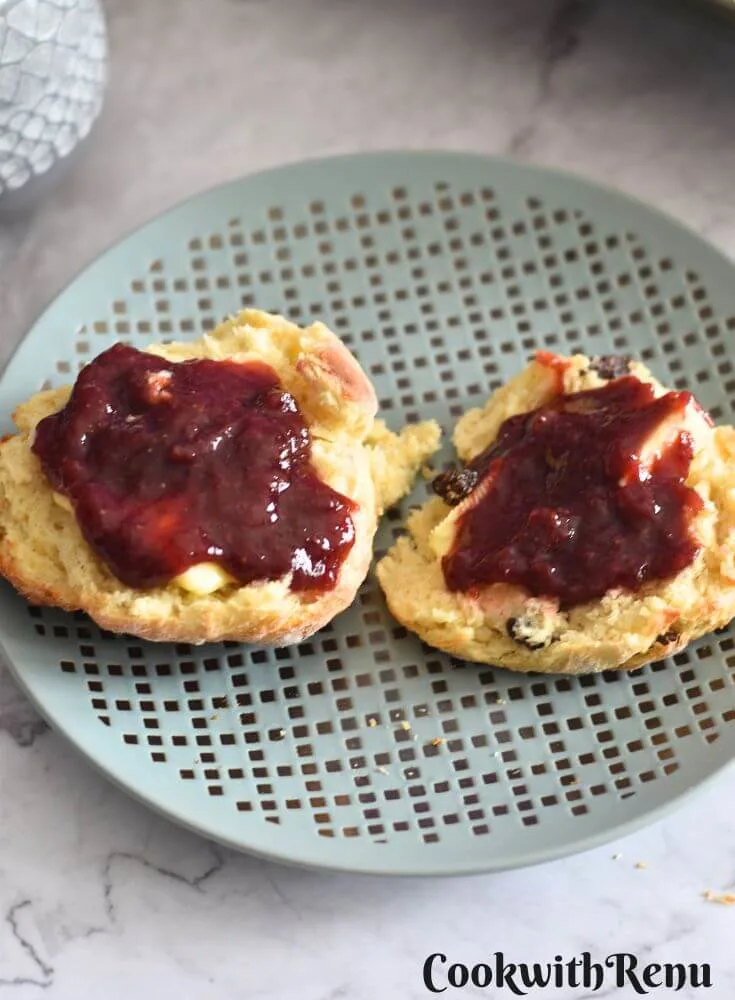
These scones stand out for their simplicity, using everyday pantry staples that let the flavor shine. Whether you like them plain, with raisins, or served with butter and jam, you’ll discover why they’ve become a favorite across kitchens in Ireland and beyond. In this post, you’ll get a taste of what makes authentic Irish scones so special, plus a few fresh takes to try at home.
- My Story with Scones
- Scones in Irish Homes
- The Role of Scones at Tea Time
- Traditional Irish Scone Ingredients and Techniques
- Essential Ingredients in Irish Scones
- Irish Baking Techniques: What Makes Scones Unique?
- How to Make Authentic Irish Scones at Home
- Common Mistakes and How to Avoid Them
- Serving and Enjoying Irish Scones
- Creative Irish Scone Flavor Variations
- Conclusion
- Few Irish Recipes on my blog
- Irish Scones
- Sharing this with
My Story with Scones
When I tried Scones at the restaurants I never liked it. They seem to be dry, but there was something that kept me looking too. I always tried it and always was like why is it dry. But then once I stayed at an Air BNB in Ireland and the host baked some fresh homemade Scones for us. At first we were like, gosh how do we eat this as It’s just me who tries them and the husband and kids were strict no no. But then when I ate, I was like wow this is it. I want this recipe. The scones had the perfect tender crumb, lightly sweet and best with a cuppa. My family too enjoyed it and we wished if we could get another batch.
From then I knew which scones were the best or who served the best. But then I started my search for the recipe. I always wanted to bake at home. I tried one scone recipe earlier, but it failed to my liking. So I was on the hunt for the perfect Scone recipe. Finally after seeing 3-4 recipes on google for Irish Scones, I found one. All had the same recipe and the same story.
All the recipes said that the scones were their favourite when they were kids and now I understand why. Also a favourite of their mom’s as they were quick to make. Yes real quick. You mix and bake and guess what the baking time is just 10 mins. You have breakfast or a snack ready in as little as 20-25 mins.
I always wanted to bake this but that day never came. So I decided to host the Bread Bakers event for today and asked all my friends to make scones. Do check at the bottom the different scone recipes they made. My Pics are not doing the justice to the scones. As I took them in a hurry with all my family upon me to finish it soon.
Scones in Irish Homes
When you think of an Irish kitchen, you might picture the kettle always ready, plates of scones in the center of the table, and family crowding in for a chat. Scones are common at breakfast, but you’ll also see them in lunchboxes, after school, or as a snack with a glass of milk. These baked treats are often tied to the idea of home, sharing, and hospitality.
- Easy to make: You needed little more than flour, butter, milk, baking powder, and a pinch of salt. That made scones handy for busy households.
- Family recipes: Many Irish families have a scone recipe scribbled on a card, swapped at gatherings, or passed from parent to child.
- Always fresh: The best scones come straight from the oven, the way Irish families have done for years.
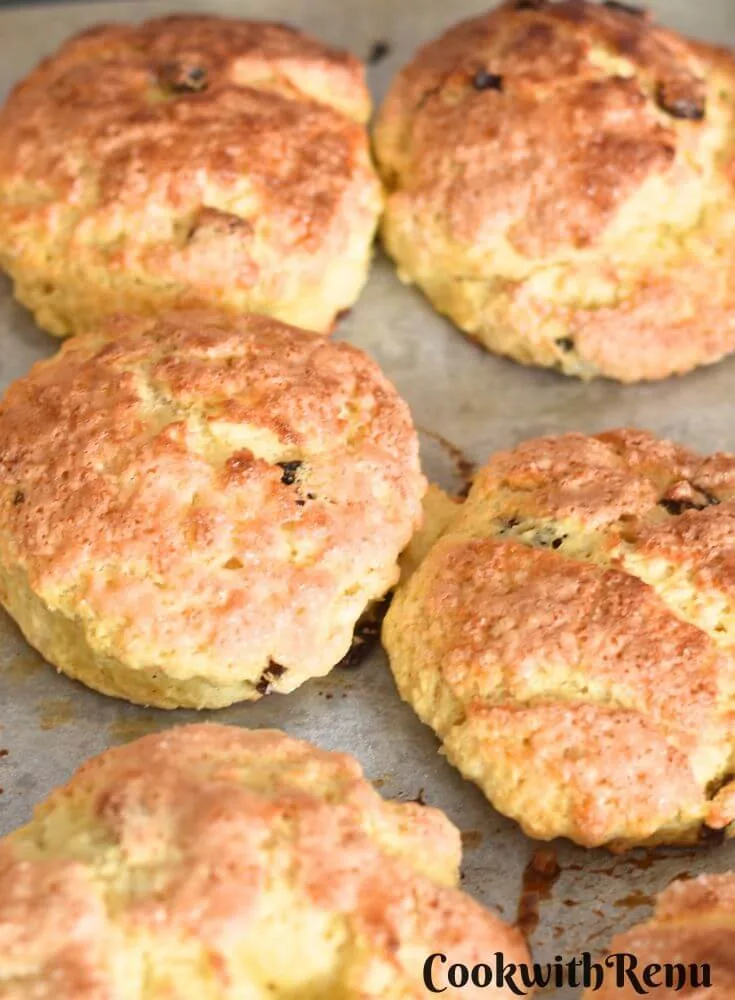
The Role of Scones at Tea Time
Tea time is a ritual in Ireland, and scones are the star of the spread. When friends drop by or neighbors pop in, a pot of strong tea and a plate of scones are what you offer first. These moments aren’t just about food; they’re about connection.
- A sign of welcome: Offering scones is a simple way to say, “you’re invited” or “sit, stay a while.”
- Served with extras: In Ireland, scones might come with jam, butter, or a thick layer of cream, depending on the house and region.
- Not just for special days: Scones are baked for birthdays, holidays, and especially on plain old rainy afternoons, which Ireland has plenty of.
Traditional Irish Scone Ingredients and Techniques
The heart of any good Irish scone lies in its humble ingredients and tried-and-true baking methods. Nailing the classic flavor and texture takes more than just following a recipe. It’s about knowing what goes into the dough, how to handle it, and which little touches make each batch special. Let’s break down the building blocks of authentic Irish scones and the techniques that bring them to life.
Essential Ingredients in Irish Scones
Irish scones call for a short, familiar list of ingredients, but every item has a purpose. Here’s what you’ll find in a truly traditional batch:
- Plain white flour: Most bakers use standard wheat flour. Some regions in Ireland might add a bit of wholemeal for texture, but the base is always plain flour for that signature crumb.
- Raising agent: Self-raising flour is now common, but older recipes stick with baking powder and baking soda, sometimes mixed with a touch of cream of tartar. The balance gives scones their gentle lift.
- Butter: Real Irish butter makes all the difference. It gives scones richness and that soft, tender bite. Many bakers grate cold butter into the flour or rub it in by hand, aiming for pieces no larger than peas. And by cold I mean frozen butter.
- Sugar: Just enough sugar to bring a mild sweetness. Scones shouldn’t taste like cake—add a small handful, no more.
- Buttermilk: Classic scones are moistened and bound with buttermilk, which gives a slight tang and helps the scones bake up fluffy inside. Milk is also used and I have used milk in my recipe.
- Egg (optional): Some family recipes include an egg for color and richness, but it’s not a strict rule.
- Salt: Just a pinch to balance flavors.
- Dried fruit (optional): Many traditional scones include currants, sultanas, or raisins. In some regions, bakers add zest from an orange or lemon for a twist.
Irish Baking Techniques: What Makes Scones Unique?
Winning Irish scones share a few common techniques passed down through cooks and grandmothers. You don’t need a stand mixer or a list of gadgets. What matters is the light touch and steady hand:
- Cold ingredients: Butter and milk must be cold when added to the flour. This keeps the fat from melting and helps scones rise with flaky layers.The cold butter when mixed in the flour and when baked create air pockets and help the scone to rise.
- Gentle mixing: Over-mixing is the enemy of a tender scone. Stir just until the dough comes together; it’s meant to look a bit rough and shaggy.
- Quick handling: Work quickly so the butter stays cold. If your hands get warm, rinse them under cool water before rubbing in the butter.
- Thickness matters: Roll or pat the dough to at least 1 inch thick. Thicker dough means taller, fluffier scones. I rolled the first few nicely, and then I went a bit wrong in the last as when I was assembling the crumbs. But that’s fine, they came good.
- Sharp edges: When cutting rounds, use a floured biscuit cutter and avoid twisting. This keeps the edges clean so scones rise up, not out.
- Simple bake: Most Irish scones bake in a hot oven, 400 Deg F or a bit higher. The quick blast of heat helps them puff up and brown on top. I did bake it at a 446 Deg F or 230 Deg C
- Finishing touches: Brush with a bit of milk or beaten egg for a golden finish. Some like to sprinkle a little extra sugar on top for crunch. I literally dipped my scone in sugar for that crumbly and golden top.
These time-honored steps give Irish scones their classic crumb: light, tender, and never dry. Every home baker brings a bit of their own style, but the basics stay the same. Stick close to tradition, and you’ll understand why a fresh Irish scone tastes like home.

How to Make Authentic Irish Scones at Home
Baking Irish scones at home feels like inviting a piece of Ireland into your kitchen. With the right know-how and a gentle touch, you can make scones that rival any in a country café. Whether you’re new to scones or refresh your recipe every year, a few simple steps and home baker tricks keep things tasty and easy.
Step-by-Step Recipe and Helpful Tips
Start with the basics and let the process bring out the best in each ingredient. Here’s the process to nail classic Irish scones:
- Gather your ingredients: You’ll need plain (all-purpose) flour, cold butter, sugar, baking powder, a pinch of salt, buttermilk, and an egg. Have currants or raisins ready if you want fruit scones.
- Preheat your oven: Set it to 446°F (230°C) to get that quick, even rise.
- Mix the dry ingredients: Sift flour, baking powder, sugar, and salt into a large bowl.
- Add the butter: Freeze your butter, try this and you will have the best scone ever. Grate that with a grater directly into the flour mixture. Alternatively one can cut it with your fingers or a pastry cutter until the mixture looks like coarse breadcrumbs.
- Add fruit (optional): Stir in a handful of raisins, currants, or sultanas now.
- Egg and Milk mixture: Lightly beat the eggs and add the milk in it.
- Pour in the milk mixture: Make a well in the center and pour in most of the milk mixture leaving a little aside. If required add in the remaining. And with your hand, in claw shape, mix it lightly. Just mix until it all combines. We need soft, shaggy dough. Do not overmix as that will lead to hard scones.
- Shape the dough: Turn the dough out onto a floured surface. Pat it gently to about 1 to 1.25 inches thick. Don’t roll aggressively—too much handling toughens scones.
- Cut the scones: Use a round cutter, dipping it in flour between cuts, and press down without twisting. Lay rounds on a parchment-lined baking sheet, spacing them an inch apart.
- Top and bake: Brush the tops with milk or a beaten egg for gloss. One can use the leftover milk mixture. Dip the scone in sugar or sprinkle some sugar if you like a crunchy finish.
- Bake and cool: Bake for 10-12 minutes, until golden. Let it cool in the baking tray for 5 minutes, then enjoy it warm.
Tips for bakery-style results:
- Measure everything for best consistency.
- If your kitchen is warm, chill the cut scones for five minutes before baking.
- For extra lightness, sift the flour twice.
- Serve scones the same day—they’re best warm and fresh.
Common Mistakes and How to Avoid Them
Even experienced bakers trip up with scones. Here’s what to watch for, and how to fix it:
- Over-mixing the dough: This makes scones tough, not tender. Mix with a light hand, stopping as soon as everything comes together.
- Melting the butter: When butter gets too soft, scones lose their flakiness. Always use cold butter, and work quickly. For best results freeze the butter.
- Rolling too thin: Thin dough means flat, dry scones. Keep dough over an inch thick.
- Cutting followed by twisting: Twisting the cutter seals the dough’s edges, keeping scones from rising. Press straight down, then lift.
- Oven not hot enough: Scones need a burst of high heat. Bake at or above 400°F.
- Leaving scones out too long before baking: The dough should go into the oven quickly, or the baking powder won’t do its work.
Quick reminder: Irish scones aren’t supposed to be ultra-sweet or crumbly like shortbread. A good batch is soft inside, with a crisp, golden crust.
Serving and Enjoying Irish Scones
Hot from the oven, Irish scones invite you to slow down and savor each bite. Their true charm comes alive when you serve them with classic toppings or try new flavor spins. The tradition and creativity at the table can make even a quick snack feel like a small celebration.
Classic Accompaniments: Jam and Cream
An Irish scone rarely travels solo. The simplest serving brings out their best qualities, adding a touch of comfort with every bite. For many, nothing beats the timeless trio:
- Good butter: Soft, salty Irish butter melts perfectly into a warm scone. Always serve it at room temperature, sliced thick or in curls.
- Fruit jam: Strawberry and raspberry jams are the favorites. Spoon on a layer so it seeps into the crumb without overwhelming it.
- Clotted cream: For something richer, try clotted cream or thick double cream. Not easy to find outside Ireland or the UK, but a spoonful adds a luscious touch when you can get it.
To serve, split the scone in half (no need to cut with a knife if they’re fresh baked—they break easily by hand). Spread on the butter, add a layer of jam, and finish with cream if you like. There’s an ongoing friendly debate: jam first or cream first? In Ireland, most people reach for butter before anything else, but the order is up to you.
Here’s how scones often appear at the table:
- Tea time spread: Warm scones, butter, a pot of jam, and, if you’re lucky, cream—all on a plate with a mug of strong Irish tea.
- Brunch tray: Stack of scones, flanked by bowls of fruit preserves and whipped cream for easy grabbing.
One last tip: serve scones fresh, while still warm. If they cool, a minute in a low oven brings them back to life.
Creative Irish Scone Flavor Variations
While the classic never disappoints, there’s no rule that says you can’t get playful. Irish home bakers and cafés have started to mix up scone flavors, adding their own twists and seasonal touches.
If you want to try something new, here are a few ideas that taste great without losing that Irish scone character:
- Fruity upgrades: Swap basic raisins for dried cranberries, cherries, or chopped apricots. Add a hint of orange or lemon zest for brightness.
- Savory scones: Mix in sharp cheddar, chives, or a handful of chopped sun-dried tomatoes. These go well with soups or as a breakfast treat.
- Oaty goodness: Use part rolled oats in place of plain flour for a rustic, nutty flavor.
- Spiced warmth: Try cinnamon, nutmeg, or a pinch of mixed spice in the dough. This pairs well with a cup of milky tea on a cool morning.
- Chocolate or nut mix-ins: A handful of chopped dark chocolate, walnuts, or pecans can be folded through the dough for an extra kick.
- Herb and seed toppings: Sprinkle poppy seeds, sesame seeds, or fresh herbs on top just before baking for texture and a hint of flavor.
For special occasions, shape your scones into hearts or use cookie cutters for fun. Irish scones work well as a blank canvas for whatever you dream up—just keep the base simple, and the add-ins balanced.
Trying something different can turn an everyday treat into the best part of your day, whether it’s a new combination or a fresh batch served hot from the oven.
New cafés might offer creative versions—like fruit, chocolate, or cheese scones—but the basics are always the same: good tea, good scone, good company.
Conclusion
Irish scones keep their spot as a comfort food for good reason. They’re quick to make, fit any table, and invite people to gather and enjoy simple moments. Whether you stick to traditional recipes or try a modern twist, homemade scones can turn an ordinary day into something special.
Give them a try in your own kitchen. Bake a batch, brew some tea, and bring a touch of Irish warmth to your day. Let these scones spark new memories and a bit of joy, just like they have for generations. Thanks for reading—share your baking results or family stories in the comments below!
Few Irish Recipes on my blog



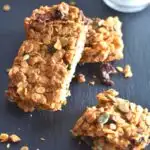
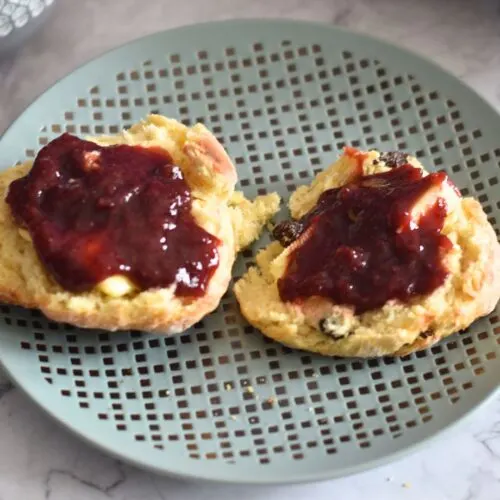
Irish Scones
Equipment
- Grator
Ingredients
- 450 grams plain white flour
- 90 grams butter Cold, Frozen is best
- 2 small eggs
- pinch salt
- 25 grams castor sugar
- 2 teaspoons baking powder
- 225 ml milk
- Raisins/Sulatanas Optional
To glaze:
- Egg wash saved from egg and milk mix
- castor Sugar or Demerara sugar or coarse granulated sugar for coating the top of the scones
Instructions
- Preheat your oven to 446°F (230°C).
Making of Dough
- Sift flour, baking powder, sugar, and salt into a large bowl.450 grams plain white flour, 25 grams castor sugar, 2 teaspoons baking powder, pinch salt
- Grate the frozen butter with a grater directly into the flour mixture. Alternatively one can cut it with your fingers or a pastry cutter until the mixture looks like coarse breadcrumbs.90 grams butter
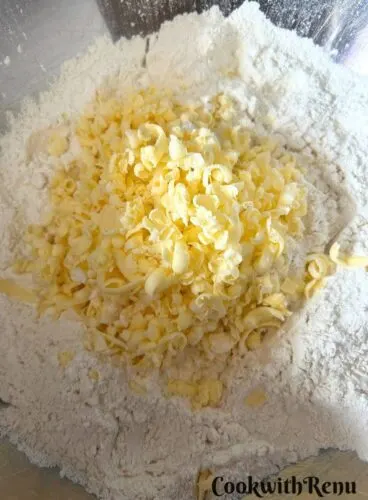
- Add raisins or currants, or sultanas if using. Lightly rub the butter and raisins into the flour mixture.Raisins/Sulatanas
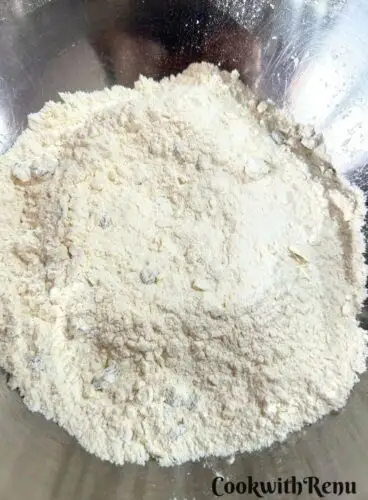
- In a small bowl, beat the eggs and add milk to it.2 small eggs, 225 ml milk

- Make a well in the center of the dry mix and pour in most of the milk mixture leaving a little aside.
- With your hand, in claw shape, mix it lightly. Just mix until it all combines. We need soft, shaggy dough.
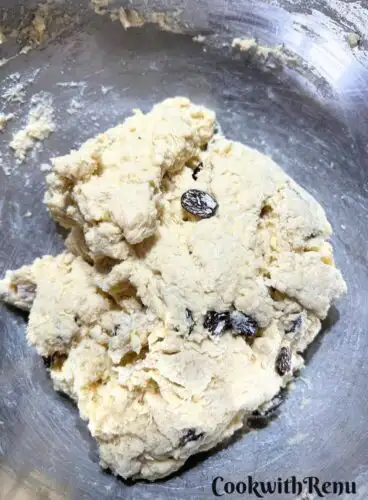
- If the dough appears dry, add more milk and egg mixture.
- Do not overmix as that will lead to hard scones.
Shape the dough
- Turn the dough out onto a floured surface. Pat it gently to about 1 to 1.25 inches thick. Don’t roll aggressively—too much handling toughens scones.
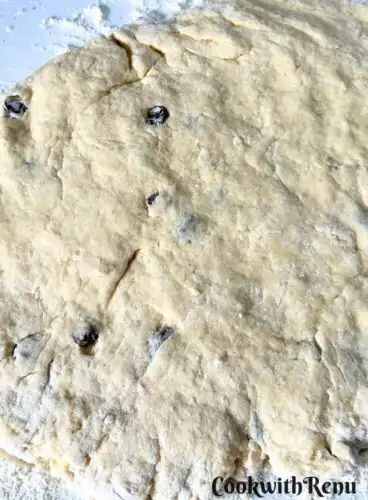
- Use a round cutter, dipping it in flour between cuts, and press down without twisting.
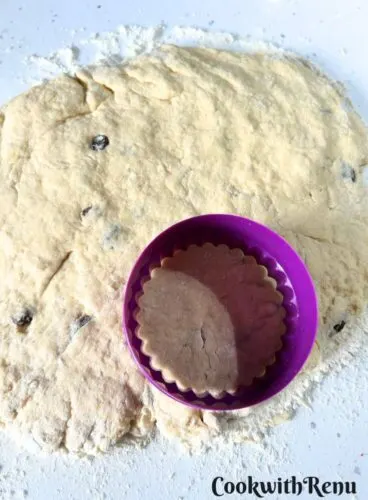
- Lay rounds on a parchment-lined baking sheet, spacing them an inch apart.
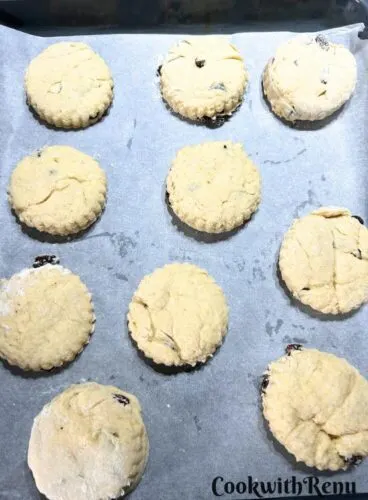
Top and bake
- Brush the tops with milk or a beaten egg for gloss. One can use the leftover milk mixture.Egg wash
- Dip the scone in sugar or sprinkle some sugar if you like a crunchy finish.castor Sugar or Demerara sugar or coarse granulated sugar for coating the top of the scones

- Bake for 10-12 minutes, until golden. Let it cool in the baking tray for 5 minutes, then enjoy it warm

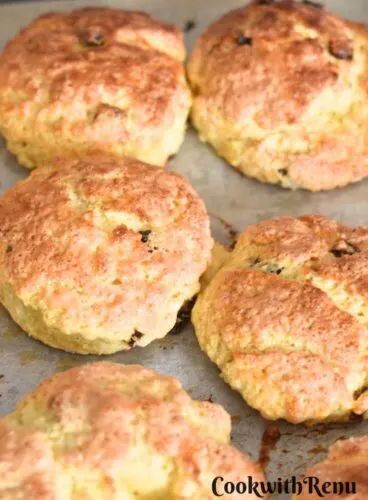
Notes
Measure everything for best consistency.
If your kitchen is warm, chill the cut scones for five minutes before baking.
For extra lightness, sift the flour twice.
Serve scones the same day—they’re best warm and fresh.
- Common Mistakes and How to Avoid Them
Even experienced bakers trip up with scones. Here’s what to watch for, and how to fix it:
Over-mixing the dough: This makes scones tough, not tender. Mix with a light hand, stopping as soon as everything comes together.
Melting the butter: When butter gets too soft, scones lose their flakiness. Always use cold butter, and work quickly. For best results freeze the butter.
Rolling too thin: Thin dough means flat, dry scones. Keep dough over an inch thick.
Cutting followed by twisting: Twisting the cutter seals the dough’s edges, keeping scones from rising. Press straight down, then lift.
Oven not hot enough: Scones need a burst of high heat. Bake at or above 400°F.
Leaving scones out too long before baking: The dough should go into the oven quickly, or the baking powder won’t do its work.
Quick reminder: Irish scones aren’t supposed to be ultra-sweet or crumbly like shortbread. A good batch is soft inside, with a crisp, golden crust.
Sharing this with
Bread Bakers
Where the theme of this month is Scones hosted by me. Do check what my friends have shared for this recipe.
- Filled Ginger Scones from A Messy Kitchen
- Fresh Peach Scones from The Wimpy Vegetarian
- Gingerbread Scones from Karen’s Kitchen Stories
- Irish Scones from Cook with Renu
- Onion Cheese Scones from Sneha’s Recipe
- Preserved Lemon Scones from A Day in the Life on the Farm
- Tattie Scones from Food Lust People Love

BreadBakers is a group of bread loving bakers who get together once a month to bake bread with a common ingredient or theme. You can see all our lovely bread by following our Pinterest board right here. Links are also updated after each event on the #BreadBakers home page. We take turns hosting each month and choosing the theme/ingredient.
Tried this recipe? Please comment and rate the recipe. Share your pics and tag us.
Subscribe to my email list to get the new recipes straight into your mailbox.


Sneha Datar
Thursday 14th of August 2025
These scones are delicious!
Wendy Klik
Wednesday 13th of August 2025
Yay for perseverence and success!!
Renu Agrawal Dongre
Wednesday 13th of August 2025
Thank You
Karen @karenskitchenstories
Wednesday 13th of August 2025
These sound wonderful and I love your story about discovering them. Much better than a traditional Irish breakfast!
Renu Agrawal Dongre
Wednesday 13th of August 2025
Thank You :-)
Susan
Tuesday 12th of August 2025
I keep trying to remember to freeze butter and this is the perfect way to use it. I had no idea that Irish scones were different and want to try your recipe. So many scones are dry. Like Stacy, I was really surprised to see the oven temp. Thank you so much for hosting us this month and for choosing scones!
Renu Agrawal Dongre
Wednesday 13th of August 2025
Yes, they are. We learn about different cultures through blogging. Thank You
Kelly
Tuesday 12th of August 2025
I get 2 lb of Kerrygold at a time every time I go to Costco. These look delightful, like little mini soda breads only so much more tender!
Renu Agrawal Dongre
Wednesday 13th of August 2025
Yes, it sounds similar, but they are way different.